Archive for the ‘Kebari (flies)’ Category
Katsutoshi Amano 勝利天野 Tenkara Fly Tying and Profile
Yesterday I was able to spend time with the well known Mr. Katsutoshi Amano. One of the few people considered to be a living tenkara master in Japan, Amano-sensei is very well known in fishing circles in Japan. He may be the longest-living practitioner of tenkara in Japan. And, his fly-tying is very simple and interesting, for he uses no vise, and eyeless-hooks.
This was our second meeting, the first time was a few weeks ago, when Amano-sensei was teaching a class on tenkara with Dr. Ishigaki and Kurakami-san. We fished together for 2 days and also sat down for a fly-tying demonstration at the end of day 1.
He struck me as a very interesting character and as someone who would probably have a very interesting tenkara history to tell. I wanted to ask him many more questions, so asked if he could spare some time to do a fly-tying demonstration and interview. He invited us to his minshuku (a type of hotel that is relatively inexpensive and offers food) in Hagiwara (15 minutes from Mazegawa). If you ever come to this area, you may want to spend some time at his place, at least stop by for lunch as there is a wonderful collection of fishing tackle at his minshuku.
Written by tenkarausa
June 7, 2011 at 10:38 pm
Posted in About Tenkara, Kebari (flies)
Tagged with amano, fly-tying, katsutoshi amano, sakasa kebari, tenkara fly tying, 勝利天野
Hoba Sushi and Tenkara Flies Kids in Japan also don't know what tenkara is…
Today a group of school kids from the area came to visit the Mazegawa Fishing Center. The plan had originally been to do outdoor activities with the kids, but the bad weather of the last few days forced the teachers to find something to do indoors. They decided to teach the kids about a local traditional food called “Hoba Sushi”. Hoba sushi is a sushi that is wrapped inside a hoba leaf for easy transportation. The hoba leaf has antibacterial properties. This method of preparing the sushi was developed by farmers as an easy way to carry their food. I suspect that it was also a popular food with tenkara fishermen back in the day, but who knows? It’s original to this area (the area is called Minami Hida).

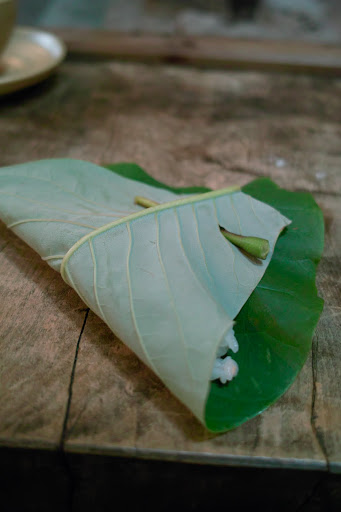
This being the fishing center, and with my presence here, the topic of tenkara obviously had to come up. We asked the kids how many of them knew what “tenkara” was. Out of 15 kids, only one raised his hand. We asked them if anyone knew what fly-fishing was, the same kid raised his hand. His dad is an avid angler. It’s a shame that so few kids from this area know what this method of fishing is. So, we explained to them the concept of tenkara, how it’s a traditional Japanese method of fishing practiced in the mountain streams of this area. I also did a fly-tying demonstration. As you know, tenkara flies are very simple to tie, so we gave a couple of the kids a chance to try it. The fishing kid was the first to volunteer. It was his first fly, and he was very good at it. A natural tying whizz.
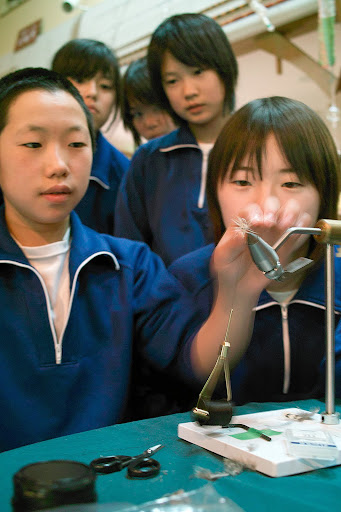
Not having enough time to get all kids to try fly-tying today, I gave a fly to each of them. They were very inspired by the concept of fishing with a fake fly. We also talked about tenkara nets. I was invited to come give a presentation on tenkara in the local school in the next couple of weeks. In the US, as well as in Japan, the population of people interested in fishing is declining. There are many reasons this should concern us, and I’m glad to contribute a small amount here too.

Written by tenkarausa
June 1, 2011 at 10:45 pm
Posted in Japan, Kebari (flies)
Tagged with hoba sushi, minami hida, tenkara fly, tenkara fly fishing, tenkara kids
2nd Tenkara Fly Swap Slideshow
For the past several days we have featured 2 flies a day, the results of the awesome flies tied by the participants of the second “Tenkara Fly Swap” hosted through the forum. Here’s a recap, of the flies in the form of a quick slideshow:
https://picasaweb.google.com/s/c/bin/slideshow.swf
Written by tenkarausa
March 6, 2011 at 2:10 pm
Posted in Kebari (flies)
Tenkara Flies of the Day V Tenkara Fly Swap
Three beautiful tenkara flies today:

Tied by Kuhlow
Mr. Kuhlow from our forum tied the nice western/tenkara hybrid above, he says, “I called it the Royal Sakasa Kebari for kind of obvious reasons. When I first tied it, I was thinking about what kind of kebari would be great for small stream brook trout. Then I thought why not combine the best aspects of a sakasa kebari (namely the reverse hackle) and another proven fly, the Royal Coachman. That fly has been around since 1878 and worked so well that numerous other types of flies have used it’s color scheme. So I applied the herl and silk red band and reverse tied partridge hackle to a scud hook and away I went. It became one of my best flies for brookies last year. The only issue I have now is that I have tied so many new patterns this past winter I wonder if I’ll get a chance to fish it this coming year!”
Below is John Burge’s take on a classic tenkara fly, tied after one of Yoshikazu Fujioka’s favorite patterns, and I think its visibility will be a great asset in a fast flowing mountain stream.
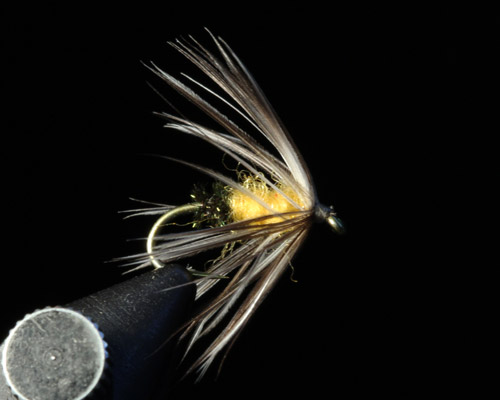
Tied by John Burge
Bob Kern (Narcodog) tied the fly below, I really like the way the hackle matches the body. I kept the photograph a bit dark to accentuate the yellow of the hackle and the body.
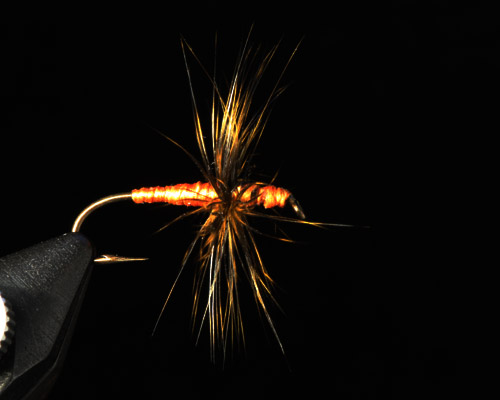
Tied by Narcodog
Written by tenkarausa
March 5, 2011 at 10:45 am
Posted in Kebari (flies)
Tagged with fly swap, mountain stream fly fishing, tenkara flies, tenkara fly
Tenkara Flies of the Day III
Karel Lansky, of the website http://www.tenkaraonthefly.net/ tied the first fly featured today, and says, “I wanted to crate a fly imitating a very widespread insect, a caddis, fished as pupa, with a dubbed body instead of the thread to achieve more “shaggyness”. Oh, yes, it’s all about the shaggyness, as he says, “thought a caddis pupa imitation might be something trout would not pass up.”
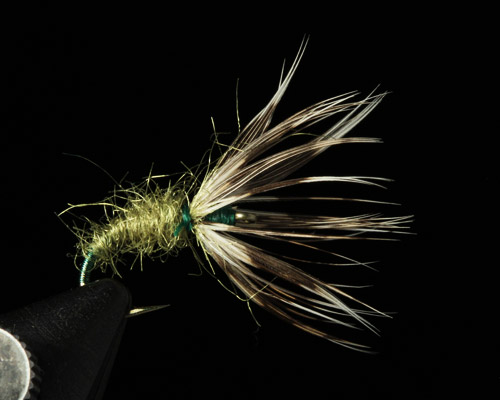
Tied by Karel Lansky of tenkaraonthefly.net
Andrew Berner tied the fly below, and says, “Mine was the red reverse Ishigaki Kebari. I just got all the stuff to tie flies and actually made two other batches of twelve and picked this third batch that looked the best. I’m new to this tying thing and I don’t think mine are as good as others but am really excited to try them out and see if they work. I used some 6/0 thread, hungarian partridge and red peacock herl. I’m really excited about tying as much as I can and want a bunch of good flies before the season starts this April.”
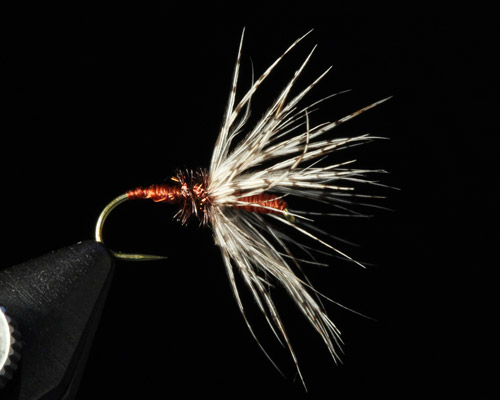
Tied by Andrew Berner (Berner9)
Written by tenkarausa
March 3, 2011 at 10:00 am
Posted in Kebari (flies)
Tagged with sakasa kebari, tenkara flies, tenkara fly, tenkara fly swap
Tenkara Flies of the Day I Tenkara Fly Swap
How I love our community of tenkara anglers, their enthusiasm and passion for tenkara inspires me to run Tenkara USA and try to make it better every day. As the flies of our second tenkara fly swapare put in the mail for the recipients, I will be featuring 2 flies a day on the blog. Keep coming back!
Forum user, Heineken, tied the beautiful fly below.
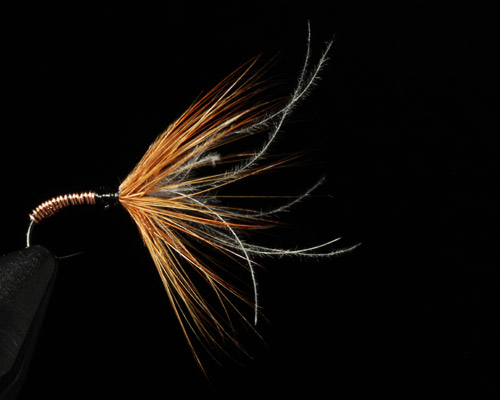
Tied by "Heineken"
Heineken says, “Hi Daniel ,
I had no time to come up with a little story behind my micro sakasa kebari earlier. Here it is
My objective was to tie a dry fly for quieter pools and streams where picky trout are feeding on small insects off the surface.I wanted to incorporate a little more movement in the hackle so I added some white fibres of culle de canard. The copperwire has to weigh down the body to ensure penetration of the water film, since the fly is very light, and a parachute like landing. Hook: Tiemco 103 bl | Thread : Black 0/8 uni | Rib: Copper wire fine | Hackle: Red cock hackle (Brahman) | Wing: White culle de canard | Simple enough ?
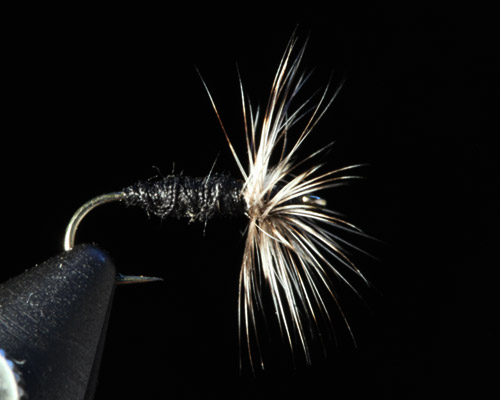
Ugly fly by Daniel
My fly was an “ugly” functional fly, and my take on a “original kebari”. I tied a fly to accomplish one goal: to sink effectively while using the simplest materials, thread and hackle. Actually, there is a bit of a story behind how I learned about this fly. Last September, Dr. Ishigaki came to visit and fish in California. On one of the days we went fishing for golden trout, on a gorgeous mountain stream with many very calm pools. One of the pools had a good number of fish, but they were only going for flies about 2-3ft under. While we could get to them with other flies, it took a while for them to sink. So, after a few minutes he pulled this “secret” weapon. I had seen his fly box many times Yet, I never noticed this “different” fly, which was tied with a lot more thread on the body. We tied this fly on, cast to the pool, and observed it sinking twice as fast. And, we could now catch twice as many fish, still using one pattern.
Written by tenkarausa
March 1, 2011 at 10:00 am
Posted in Fishing technique, Kebari (flies)
Tagged with fly swap, heavy tenkara fly, original tenkara fly, sakasa kebari, tenkara flies, tenkara fly, tenkara fly swap
Talking of tenkara flies… Tenkara flies analyzed
Some people consider winter the fly-tying season, thus our recent posts on tenkara fly-tying. With the very large number of new tenkara adopters and readers of our blog since this the post below, I thought it would be appropriate to “recycle” a previous post on “Tenkara Flies analyzed”. This is not to form a habit, but there is some really good content in past posts…maybe a book in the making?
Originally posted on June 25th, 2009. Slightly edited here:
While the most characteristic tenkara flies are the so-called “sakasa kebari”, or reverse hackle flies, these are not the only type of fly used in tenkara. Over the years, Mr. Yoshikazu Fujioka, from the website “My Best Mountain Streams”, has researched and collected traditional tenkara flies from different regions of Japan. Now, Fujioka sensei gives us a very nice, yet, tenkara-like simple, analysis of tenkara flies. Like classifying western flies into “dry”, “wet”, “nymphs”, etc, his analysis focuses specifically on tenkara flies and what pattern styles are commonly found in the hands of tenkara anglers. These should serve as a good foundation to better understanding tenkara flies (if one chooses to, understanding this is not really necessary to be a successful angler). As shown in his graphic chart, even the sakasa kebari come in different forms and with different characteristics (soft hackle/stiff hackle, thick body/thin body and short/long hackle).
Typically, an experienced tenkara angler will use one pattern only. Over time, an angler will acquire preferences for a specific fly type, and will have his sole “go-to” fly, maybe a couple of different sizes and colors, but the same pattern. Not all tenkara anglers use the same fly, but each one tends to stick with only one style. Some may believe a fly with soft hackle will be more “fluid”, softer and thus may be more attractive; other people may believe a stiffer hackle facing forward is better. There is even an angler who uses snake skin to tie his flies, and he believes the reflection of the snake skin attracts fish (we just think it is a cool story!). This is largely personal preference, or maybe because of that “one great day with the one fly” they experienced.
The complete analysis of tenkara fly by Fujioka sensei can be found on the pdf document. It’s very informative and thorough, yet simple as it should be.
Written by tenkarausa
December 30, 2010 at 5:56 pm
Posted in Kebari (flies)
Tagged with fly-fishing, fly-tying, mountain stream flies, tenkara flies, tenkara fly, trout flies
Tenkara fly-tying, large sakasa kebari
A new, shorter version of the tenkara fly-tying video featured in our tea post.
Tenkara fly-tying, sakasa kebari
Demonstration on how to tie a tenkara sakasa kebari (reverse-hackle tenkara fly). This fly is tied on a large, size 8 hook. It is ideal for fishing mountain streams that are running a bit higher and you want to increase the visibility of the fly, or when you see larger bugs in the water. This is pretty much the only pattern I use, though I most often use flies in size 12. Fly-fishing for trout in mountain streams means that the fly used doesn’t need intricate details, so, any fly with a size similar to bugs in the water and general bug shape, such as the sakasa fly, should work well as long as it is presented and manipulated properly.
Written by tenkarausa
December 27, 2010 at 11:42 pm
Posted in Kebari (flies)
Tagged with mountain stream fly, tenkara fly fishing, tenkara fly tying, trout flies, trout fly tying
Tenkara Tea and Fly Tying
One of the reasons I created Tenkara USA is because I really like introducing friends to things that I love, tenkara fly-fishing, tenkara rods, tenkara nets, now tenkara tea!
Drinking high-quality green tea has long been an obsession of mine, and most recently Dr. Ishigaki turned me on to ground green tea. As luck would have it, shortly after I discovered ground green tea, a tenkara angler put me in touch with a distributor of this type of tea. I wasn’t looking for it, it just found me. So I thought, how cool would it be to make our own label and give people a chance to try it. One of the most soothing elements of Japanese culture, especially now in the fly-tying season. I hope you’ll enjoy it as much as I do. We’re offering this for a very limited time, unless there is strong demand, for only $15 for the tea, a Tenkara Tea can, and a neat bamboo whisk. Tenkara Tea
Here is a video I made especially for the occasion.
Written by tenkarausa
December 23, 2010 at 8:11 pm
Posted in Kebari (flies), Tenkara Life
Tagged with fly-tying, ground green tea, tenkara fly tying, tenkara tea
One fly – Doubt and Confidence
Ever since getting into the discipline of using one fly pattern/style only, with no great concern for choosing the “right” fly, but rather focusing proper fishing technique (presentation and manipulation of the fly), there have been moments of doubt. However, I have chosen to rely less on gear and perfect technique instead. I wanted to learn more, to become proficient at fishing, not spend my time changing flies. Further, I’m very attracted to the idea that whether I catch a fish or not is entirely up to me and my technique, and that if a fish is not biting maybe I could do something slightly different. This thought, that maybe it’s not my fly selection, but rather my technique on fishing it, have dramatically pushed me to become a better angler. I have stuck with using a tenkara fly only (mostly size 12), no matter where I fish, or what is hatching. Also, absolutely no indicators, no floatant and no weight! To once again borrow the words of Yvon Chouinard on the subject, “I believe the way toward mastery of any endeavor is to work toward simplicity; replace complex technology with knowledge, hard work and skill.”
Since the idea of sticking with one fly and relying solely on my technique is still relatively new to me, sometimes doubt creeps in. This is especially true if I find myself fishing a bigger, slower river, like the Madison, for which everyone has advice on what fly to use and for which there are dozens of books on what specific patterns to use at different times of the year, etc. And, it’s also true if I find myself in the company of very experienced anglers, like John Gierach and Ed Engle, who may be using different patterns in a stream they know well. And, it is especially the case if the day is slow. In these situations it’s very easy to lose confidence in my technique, in the techniques I can use to attract fish, and start thinking that maybe they are right! But are they? The western thought of matching the hatch is so ingrained in our minds that it’s hard to let go of it and realize that a couple of hundred years ago professional tenkara anglers, in the mountains of Japan, who depended on catching trout for a living, made it happen with one fly pattern and flawless technique. Nowadays that is the approach taken by tenkara anglers in Japan, for sport, and they continue catching fish.
Written by tenkarausa
September 4, 2010 at 9:55 pm
Posted in Kebari (flies), Tenkara Technique
Tagged with Madison Fly Fishing Festival, Madison River, one fly, tenkara fly, tenkara fly fishing
Tenkara flies analyzed by Fujioka-sensei
While we subscribe to the theory that fishing is extremely simple, and that a person can successfully fish with one fly pattern, whatever pattern they choose, we also really like tenkara flies. They come in different shapes, colors, sizes and with unique details about each of them. Due to the research and interest of Mr. Yoshikazu Fujioka, from the website “My Best Mountain Streams”, we have been able to learn a lot about tenkara flies, their geographic origins and some of their history.
Mr. Fujioka is our tenkara fly teacher, our tenkara kebari sensei, and also helped us put together our current selection of flies. Over the years he has researched and collected traditional tenkara flies from different regions of Japan. Now, Fujioka sensei gives us a very nice, yet, tenkara-like simple, analysis of tenkara flies. Like classifying western flies into “dry”, “wet”, “nymphs”, etc, his analysis focuses specifically on tenkara flies and what pattern styles are commonly found in the hands of tenkara anglers. These should serve as a good foundation to better understanding tenkara flies (if one chooses to, understanding this is not really necessary to be a successful angler).
While the most characteristic tenkara flies are the so-called “sakasa kebari”, or reverse hackle flies, these are not the only type of fly used in tenkara, and as shown in his graphic chart, even the sakasa kebari come in different forms and with different characteristics (soft hackle/stiff hackle, thick body/thin body and short/long hackle).
Typically, an experienced tenkara angler will use one pattern only. Over time, an angler will acquire preferences for a specific fly type, and will have his “go-to” fly. Not all tenkara anglers use the same fly as each other, but each one tends to stick with only one style. Some may believe a fly with soft hackle will be more “fluid”, softer and thus may be more attractive; other people may believe a stiffer hackle facing forward is better at attracting fish. Yet, others will tie any fly they find to be the simplest and quickest to tie. This is what Fujioka sensei shows in his analysis of tenkara flies.
The complete analysis of tenkara fly by Fujioka sensei can be found on the pdf document. It’s very informative and thorough, yet simple as it should be.
Written by tenkarausa
June 25, 2010 at 2:21 am
Posted in Kebari (flies)
Tagged with Fujioka, tenkara flies
Fly Tying material: Zenmai (Fern dubbing)
I love the idea of using natural materials on all my flies. Through tenkara I learned about a material most people accustomed to the western fly-tying traditions have never heard of and very few have used, even though its properties make it a great material and it’s available in most parts of the world, including the US: the zenmai.
The zenmai was first introduced to me by Fujioka sensei, my teacher of tenkara flies, through his excellent website. A few months ago he sent me some flies, and also a small bit of zenmai, which I would not dare use as they belong to the “museum”. While fishing with Fujioka sensei, I asked if he had seen any zenmai around, “it’s a bit too late in the season”, he replied. Usually the zenmai comes out in very early spring and the fleece falls off soon after. However, as luck would have it, Fujioka sensei later went to an onsen (hot springs) at a higher elevation and there he was able to find some.
Fly tied by Fujioka sensei using the zenmai dubbing material.
The zenmai is a type of fern that, in early spring, has a cotton-like material on its body. This cotton-like material makes for excellent dubbing material, it is relatively waterproof, and can be easily made into a tight thread. Depending on the time it is picked or the plant it is picked from, the zenmai will vary slightly in color, with some being darker, and more commonly found in a light tan color.
Usually referred to as “flowering fern”, the zenmai belongs to the Osmunda family. The Japanese species is the Osmunda japonica, but according to Fujioka sensei the zenmai may be found worldwide, except for Australasia. The plant can be found in two stages with fleece still on its body: more commonly it’s found as a fiddlehead fern, a young shoot coming out of the ground and still curled up with fleece covering it almost entirely. Or, as a grown plant with the fleece material still on its stems, like in this video.
Though a bit hard to find at this time of year, there were still a few plants around during my visit (late May-early June). The day after Fujioka sensei gave me some zenmai, I found one plant with the fleece still attached to its body. The following week, as I visited my wife’s grandparents farther north in Yamagata, they found some more zenmai stalks while picking sansai (mountain vegetables). That’s another cool thing about this plant, the Japanese zenmai is an edible plant, a sansai, which is commonly picked by people in the mountains areas of Japan. The cotton-like material is discarded, and the meaty vegetable prepared and eaten. On this day, vegetable picking proved to be more productive than fishing (the water was too cold, I believe). Among a couple of enormous bags we picked of warabi, and fuki were a few young fiddlehead ferns still fully covered in zenmai fleece.
After being dried for a while, the zenmai can be prepared as a delicious mountain vegetable. We had some awesome meals with these on the side.
Hands full of sansai. In this case, warabi.
I know some tenkara anglers in the US have already picked North American zenmai this year, for their own flies. But, I’m afraid this post may be too late for most people to be able to find it now.
Written by tenkarausa
June 16, 2010 at 8:50 am
Posted in Kebari (flies)
Tagged with flowering fern, zenmai, zenmai flies, zenmai kebari
The Mamushi Kebari
Near Gujo, on our way up to the Itoshiro river, we stopped at a well known tackle shop run by Hirata-san. Hirata-san is known in the area, and among the tenkara community, for his specialty flies, the mamushi kebari, or snake flies. In his forays, if he runs across a mamushi, a highly venomous snake, he’ll catch it and use the skin to tie his tenkara flies.
While, as I mentioned before, one fly pattern should be enough for successful fishing, different anglers will have different opinions on what works best. Hirata-san thinks the mottled look of the snake skin, along with its slight reflective surface, are highly attractive to fish. At $10 each they are not cheap, but he justifies it by saying that “I’m risking my life to make these flies”. I figured they would be a nice addition to the tenkara museum.

Hirata san in his tackle shop, home of the Mamushi kebari (snake skin fly)
Written by tenkarausa
June 14, 2010 at 7:00 am
Posted in Kebari (flies)
Tagged with mamushi kebari, snake fly, tenkara fly
Flies? One fly is all you need.
Despite the prolific hatches I witnessed while visiting the Itoshiro River in Japan – I saw large size 8 mayflies flying around every day, small caddis flies, some stoneflies, not to mention the numerous damsel flies, and midges – matching the hatch is really not something you do, or need to do in tenkara. As a matter of fact, it’s widely agreed among the entire tenkara population that you do not need more than one pattern to be very effective at catching fish, even if one angler will usually believe his fly is better for some reason. As a matter of fact almost all tenkara anglers stick with one fly pattern only, and these are traded as if they were business cards.
It’s funny, but sometimes I’d point out the big mayflies hatching to Dr. Ishigaki. He’d look at them, and shrug, as if to say “okay, nice, now let’s go fishing”. After a while I just stopped pointing to the bugs, and by the end of my trip they were interesting to see the way birds are, but no longer very relevant to my fishing.
A large mayfly landed on Ishigaki sensei's vest
So, if there is one point Dr. Ishigaki, probably the most renowned tenkara angler in Japan, and I would like for people to know even if they choose to ignore it, is this: you only need one fly pattern to successfully fish in streams with running water. It doesn’t matter what pattern you choose, some people prefer the sakasa flies (reverse hackle), some people the soft-hackle flies, and a few will use what look like dry flies. I’d recommend one of the traditional reverse-hackle tenkara style flies (sakasa kebari), for reasons I’ll cover on a later post on fly manipulation and presentation. You may generally pay attention to size, e.g. using flies that are slightly larger if that is the size of bugs found on the stream or if you want extra visibility (e.g. for a faster than usual stream), or smaller if the fish are scared or those are the sizes of bugs found on the stream. And, perhaps color for visibility. But, that’s about it.
Ishigaki sensei tying his famous, simple pattern.
Essentially, in faster running streams fish have few opportunities to eat, additionally they have poor eyesight. Having to decide very quickly whether to go for something floating around, they will often go for anything properly presented to them. If you’ve ever seen footage of trout feeding, you’have seen they will go for leaves, and rocks going by, and even for bugs with a big hook sticking behind, so why not any fly. After I first heard of the concept, I was able to narrow my flies down to two choices, a floating elk-hair caddis and the Ishigaki fly pattern. Now I realize one is enough, and have converted, I think you can too, if you so choose.
How did he get to that conclusion?
When Ishigaki sensei started in tenkara fishing he didn’t catch many fish. Following the scarce advice from a few books and magazines available at the time, he’d switch flies if one was not working. Additionally, the books suggested specific colors and sizes based on the time of year. Not happy with not catching fish, but wanting to know why and with his background as a scientist, Dr. Ishigaki embarked on a series of experiments on trout feeding.
Some of his first research was on the vision of fish (he’s a doctor/professor in the field of vision studies), and he concluded that their vision was very poor, and they generally can not distinguish shapes or colors. That, along with their instincts to eat food when available, and the moving water they live in, does not allow fish to select what to eat, except for the obvious size discrepancies, perhaps.
Due to his research, which received much notoriety in Japan some 30 years ago, getting very widely published in fishing magazines, and even on the major tv shows, he was put in touch with many of the tenkara experts at the time. During these meetings, he noticed that every expert only used one fly pattern while fishing, but each one used a slightly different fly, and still caught as many fish, and as effectivelly, as the next guy. So, he figured, fish will probably bite anything! (as long as it’s properly presented/manipulated)
A wet tenkara fly, the Ishigaki kebari
Give it a try too!
Being under the tutelage of Ishigaki sensei and having had the “pressure” to fish with one fly exclusively over my time in Japan, helped ascertain a new level of confidence in my abilities to catch a fish, not on the fly’s ability to attract one. Before the trip I had narrowed my choices of flies to two, a dry fly (elk-hair caddis) and a sakasa kebari. Now I’m a one fly convert. I’d urge you to give one fly a fair try for several days of fishing, you’ll simplify your fishing, learn how to use the fly properly, spend less time changing flies, more time fishing them, and finally, I believe you’ll enjoy your time fishing more.
In coming days I’ll share with you some interesting fly patterns I have come across, as well as the techniques to present and manipulate the flies.
Written by tenkarausa
June 12, 2010 at 1:53 am
Posted in Kebari (flies)
Tagged with one fly, tenkara flies, tenkara fly
